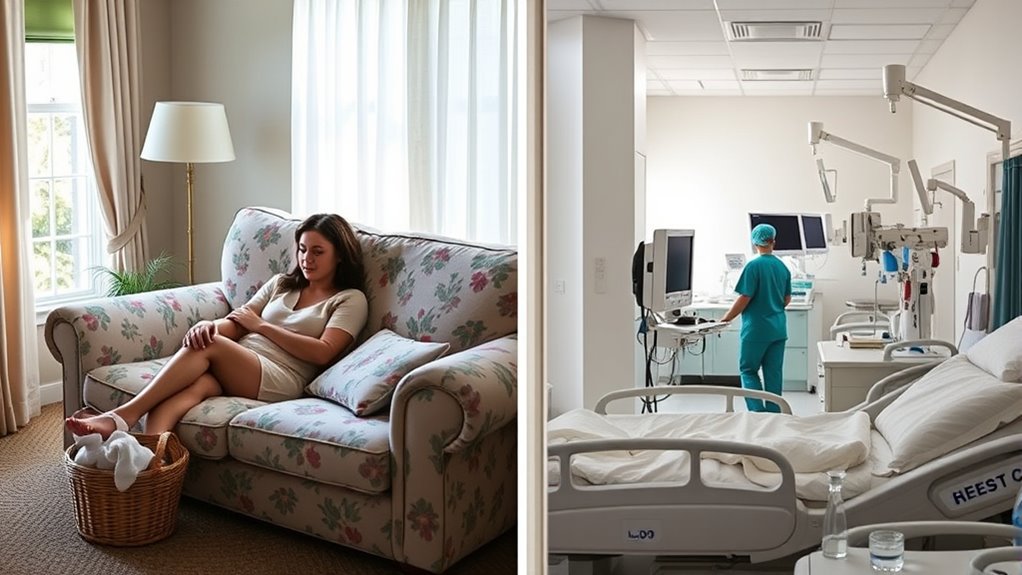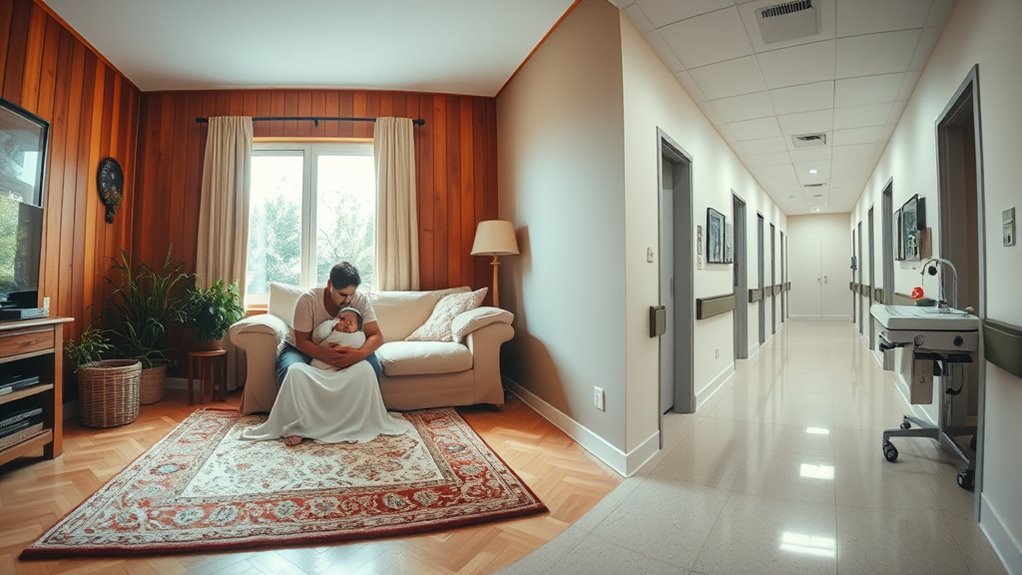Worldwide, home births are often chosen for cultural reasons and comfort, but safety depends on proper planning and risk assessment. Hospitals provide advanced medical care and emergency support, making them safer for high-risk pregnancies. Women with uncomplicated pregnancies may have equally good outcomes at home if overseen by qualified professionals. Ultimately, your choice balances personal preferences, safety concerns, and cultural values. To learn more about how outcomes compare globally, keep exploring the options and information available.
Key Takeaways
- Studies show comparable safety for low-risk pregnancies in home and hospital births when properly planned.
- Hospitals offer immediate access to emergency interventions, reducing risks in unforeseen complications.
- Cultural preferences and emotional support significantly influence birth outcomes and satisfaction.
- Worldwide data indicates higher intervention rates in hospitals, affecting natural birth outcomes differently.
- Maternal and neonatal outcomes depend on risk assessment, planning, and quality of care regardless of birthplace.

Are you wondering whether giving birth at home or in a hospital is the better choice for you? This decision often depends on personal values, health considerations, and cultural backgrounds. While hospitals are seen as the standard for medical safety, some women prefer home births because they value the comfort and familiarity of their own environment. It’s essential to understand that both options can be safe when properly planned, but your choice might be influenced by what you consider an acceptable level of risk and your cultural preferences. In many cultures, giving birth at home is the traditional way, rooted in centuries of practice, and aligns with community and family customs. This cultural preference can provide emotional support and a sense of continuity that hospitals might not offer. On the other hand, hospitals are equipped with advanced medical technology, and immediate access to emergency care can be reassuring, especially for high-risk pregnancies. They also tend to have standardized protocols that can handle complications swiftly, which many see as an essential aspect of alternative safety.
Your decision should consider how well your healthcare provider can support your birth plan, whether at home or in a hospital. For home births, qualified midwives often oversee the process, ensuring safety standards are met. These professionals are trained to evaluate risks and know when to transfer to a hospital if complications arise. Additionally, the presence of medical interventions can be more readily available in hospitals, providing options for managing unexpected situations. In contrast, hospital births offer a wide range of medical interventions, such as epidurals or emergency cesarean sections, which might be necessary in unforeseen situations. Many women feel safer knowing that professional medical staff is immediately available if needed. It’s also worth considering how your personal health, pregnancy history, and any medical conditions influence your choice. Women with high-risk pregnancies are generally advised to choose hospital births because of the access to specialized care. Additionally, utilizing reliable pregnancy tracking apps can help monitor your progress and identify any potential issues early, contributing to a safer birth plan. Engaging in thorough prenatal education can also empower you to make informed decisions about your birth environment.
Furthermore, understanding the cultural significance of birthplace choices can help you feel more confident in your decision-making process. Research indicates that birth environment can influence both maternal and neonatal outcomes, making informed choices even more critical. Ultimately, the decision hinges on your comfort level, cultural influences, and medical needs. If you’re drawn to the idea of a natural, low-intervention birth and have a low-risk pregnancy, a home birth might resonate with your values. Conversely, if you prefer the security of medical backup or have concerns about potential emergencies, a hospital birth could be more suitable. Remember, the best choice is one that aligns with your priorities, ensures your safety, and respects your cultural or personal preferences. Both options can be equally valid, and making an informed decision involves weighing these factors carefully. Whatever you choose, having a clear birth plan and working closely with healthcare professionals will help ensure a positive experience for you and your baby.
Frequently Asked Questions
How Do Birth Outcomes Differ Across Various Countries?
You’ll find birth outcomes vary widely across countries. Maternal mortality rates are higher in low-income nations due to limited healthcare access, while neonatal health disparities often reflect socioeconomic and infrastructural differences. In some countries, advanced medical facilities improve safety, but in others, resource shortages increase risks. Recognizing these disparities helps you understand how healthcare quality, policies, and socioeconomic factors influence maternal and neonatal health around the world.
What Cultural Factors Influence Birthplace Choices Globally?
You’re curious about what influences birthplace choices worldwide. Cultural traditions strongly shape these preferences, as some communities value home births passed down through generations, while others prioritize hospital settings for safety. Birthplace preferences often reflect societal norms, religious beliefs, and trust in healthcare systems. These factors guide women’s decisions, making cultural context essential in understanding why certain birthplaces are favored over others globally.
Are There Specific Medical Conditions That Favor Home Births?
Thinking about specific medical conditions that favor home births is like spotting clear skies before a storm. If your risk assessment reveals no medical contraindications and you’re healthy, a home birth can be a safe choice. Conditions such as stable pregnancies with no complications, previous uncomplicated deliveries, or low-risk factors typically favor home births. Always consult your healthcare provider to evaluate your individual situation and guarantee safety.
How Do Healthcare Costs Compare Between Home and Hospital Births?
When comparing healthcare costs, you’ll find that insurance coverage plays a big role in affordability for both home and hospital births. Typically, home births tend to have lower costs due to less medical intervention, but cost variability exists depending on your location and provider. Hospital births often involve higher expenses because of facility fees and emergency services. Understanding your insurance plan helps you better estimate out-of-pocket costs for either option.
What Training Do Home Birth Attendants Typically Have Worldwide?
You’ll find that home birth attendants worldwide usually have specialized training, often through certified midwife programs or nurse-midwife certification. They focus on emergency preparedness, ensuring they can handle complications if they arise. Many attend rigorous education and practical training to develop skills in monitoring fetal health and managing emergencies. This preparation helps them provide safe, competent care during home births, aligning with healthcare standards across different countries.
Conclusion
Ultimately, whether you choose a home birth or a hospital, remember that your journey is a lighthouse guiding your little one’s first steps. Each setting offers a different shade of hope and safety, like a sunrise or a steady star. Trust your instincts and surround yourself with support, knowing that your love is the guiding light through every twist and turn. Your choice shapes not just a birth, but a future filled with promise and light.









